Succulents encompass a large range of plants, but they all feature fleshy leaves and stems that store water so they can survive extended dry periods. Well-known varieties include euphorbia, crassula and aloe. Most succulents have deep or broad root systems and are native to either deserts or regions that have a semiarid season.
- Aeonium Schwarzkopf
- Aeonium Arboreum ‘Zwartkop’
- Echeveria Purple Pearl
- Graptopetalum Purple Delight
- Graptoveria Debbi
- Othonna Capensis
- Pleisopilos Nelii rubra
- Sempervivum Purple Beauty
- Senecio Crassimus
- Sedum ‘Dream Dazzler’
- Sedum ‘Plum Dazzled’
- Echeveria ‘Afterglow’
- Mangave ‘Mission To Mars’
- Anacampseros Rufescens
- Tradescantia pallida ‘Purpurea’
- Sempervivum ‘Raspberry Ice’
- Opuntia Santarita (Santa Rita Prickly Pear)
- Pleiospilos Nelii ‘Royal Flush’
- xMangave ‘Macho Mocha’
- Purple Crassula
- Sedeveria ‘Lilac Mist’
- Kalanchoe x Houghtonii
- Kalanchoe humilis
- Rainbow hedgehog cactus
- Echeveria ‘Chroma’
- String of heart
- Gymnocalycium ‘Purple Moon Cactus’
- Sedeveria Sorrento
Aeonium Schwarzkopf

Aeonium Schwarzkopf is an evergreen succulent with large rosettes, 6-8 in. across (15-20 cm), of glossy, fleshy, dark burgundy to purple, pointed leaves. If grown in full sun, the foliage of this Aeonium turns almost black, adding incredible drama and interest to the garden or containers. In part shade, the rosettes are reddish purple with a green center. Attractive when not blooming, this Aeonium is particularly striking when it produces bright golden racemes of small, star-shaped flowers in spring.
Aeonium arboreum ‘Atropurpureum’

Aeonium arboreum ‘Atropurpureum’ is an evergreen succulent with magnificent rosettes of glossy, fleshy, dark-purple leaves. If grown in full sun, the foliage of this Aeonium turns almost black, adding incredible drama and interest to the garden or containers. In part shade, the rosettes are reddish purple with a green center. Attractive when not blooming, this Aeonium is particularly striking when it produces bright golden racemes of small, star-shaped flowers in summer.
Sedum ‘Dream Dazzler’
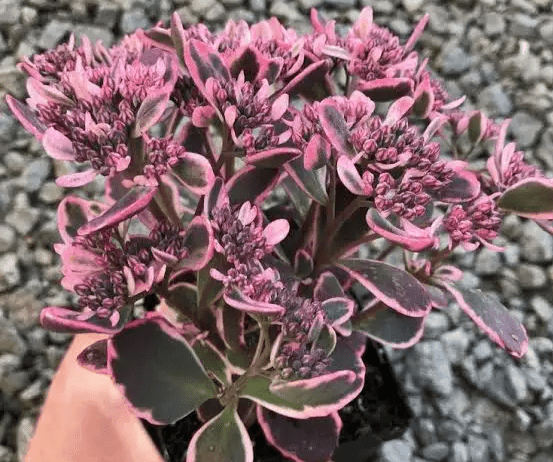
Sedum ‘Dream Dazzler’ is a mat-forming perennial with an abundance of succulent-like deep purple leaves with hot pink edges in summer. Very dense and well-branched, this sedum selection does not split open in summer and creates a colorful, weed-suppressing ground cover when planted en masse. Sitting atop short, upright stems, huge clusters of bright raspberry-pink flowers appear in late summer to early fall. A great variety for rockeries, gravel gardens and containers. Drought tolerant, ‘Dream Dazzler’ is evergreen in mild climates.
Also Read: Major Types of Succulents For Your Home Garden
Sedum ‘Plum Dazzled’

Sedum ‘Plum Dazzled’ is a mat-forming perennial with an abundance of fleshy dark purple leaves. Very dense and well-branched, this sedum selection does not split open in summer and creates a colorful, weed-suppressing ground cover when planted en masse. Sitting atop short, upright stems, clusters of large, cherry, starry flowers appear in late summer to early fall. A great variety for rockeries, gravel gardens and containers. Drought tolerant, ‘Plum Dazzled’ is evergreen in mild climates.
Echeveria ‘Purple Pearl’
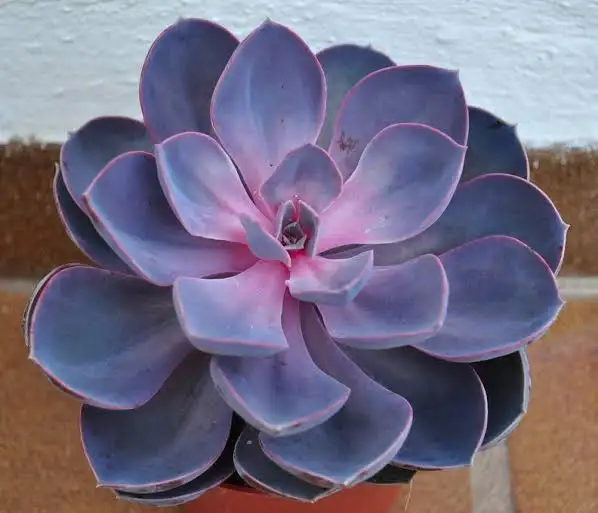
Echeveria ‘Purple Pearl’ is a popular cultivar, favoured for its attractive purple rosettes of succulent, olive green to rose-lavender coloured thin and fleshy, slightly cupped leaves. These have slightly rounded edges, with each leaf tapering to a point, the leaf edges are coloured a brighter pink-purple shade. The colouration becomes more dramatic with more sunlight. This plant produces coral pink, bell-shaped blooms on branched inflorescences measuring approximately 30cm in height.
Graptopetalum ‘Purple Delight’
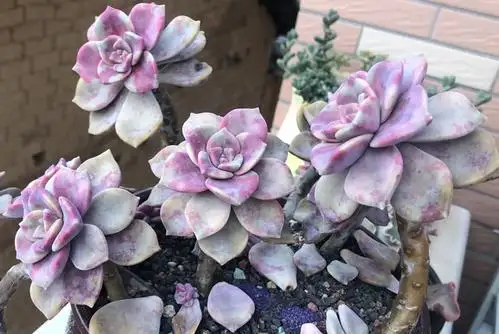
Graptopetalum ‘Purple Delight’, is also known as ‘Snow White’, produces stemless, clump-forming rosettes with plump leaves covered with farina. These leaves can margin color from lavender-purple, gray to frosy-white under stress. Like other soft succulents, Graptopetalum ‘Purple Delight’, can’t survive outdoor in cold winter. They perfer full sun light to form its best colors and shapes. Bring them indoor and place them by the window to get as much sunlight as they could or under a grow light.
Also Read: Beautiful Types of String Succulents
Graptoveria Debbie

Graptoveria Debbie’ is an Echeveria hybrid whose rosette shows off a beautiful rose shape. This beautiful succulent has flashy, frosty, blueish-purple leaves growing in a rosette. Graptoveria “Debbie” can get up to 8″ (20 cm) tall with a rosette up to 8″ (20 cm) wide. Tips of the leaves will turn pink in cooler months or when the plant is experiencing some stress. When exposed to bright sun, the leaves can get deeper coloring or even show some orange tones.
Othonna Capensis
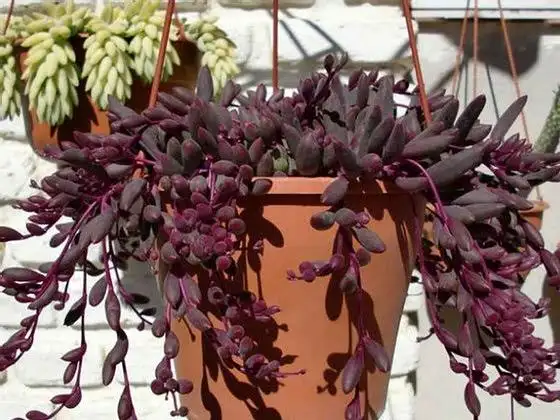
Also fondly nicknamed “ruby necklace” or “string of pickles”, this succulent is characterized by thin oval-shaped leaves and a reddish-purple stem. The size, shape and growth rate of Othonna plants vary. This succulent groundcover spreads quickly and easily in its hot, dry native environment. Most plants grow no more than two inches tall and spread to be about eight inches wide. This is a quick growing plant. For the most part, “Little Pickles” plants produce very small, dainty, yellow daisy flowers. The yellow flowers stand above the foliage on long, slim stems. Sometimes the flowers may be purple or white.
Pleisopilos Nelii rubra
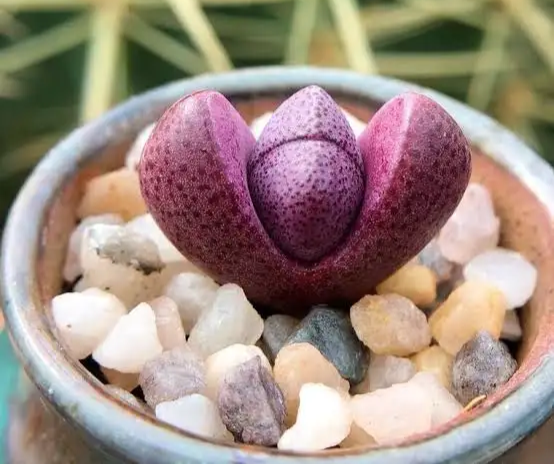
Pleiospilos nelii is perennial succulent is a short-stemmed, nearly stemless plant with one or more pairs of opposite, almost hemispherical, purple-green or brownish leaves. The surface of the leaves has many small dark spots. A new pair of leaves is produced each year, replacing an older pair. This plant closely resembles a small cracked rock (hence the common name), an appearance which may have evolved as a defence against herbivores. The superficially daisy-like flowers are yellow-orange and emerge from the plant’s apical bud. The flowers are large in relation to the size of the plant. Each flower opens in the afternoon and closes at sunset, over a bloom period of several days.
Purple Beauty Sempervivum

The Purple Beauty Sempervivum is absolutely gorgeous. The evergreen rosettes are deep purple and green. The light pink midsummer blooms attract butterflies and other pollinators. The Purple Beauty Hens and Chicks succulent is a versatile groundcover plant that stays low to the ground and spreads outward as it grows. It looks amazing in rock gardens, shallow pots, and borders. This plant is great for erosion control and works well on slopes and hills that are hard to mow.
Also Read: Different Types of Echeveria Plants
Senecio crassissimus

Senecio crassissimus also referred to as Vertical Leaf Senecio is An erect evergreen subshrub to 18-24 inches tall by 18″ wide with thick purple stems holding stiff flattened 2 inch long waxy silver-grey obovate leaves with the edges, with vivid purple margins, facing upward, which is thought to be a strategy for preventing water loss in its hot and dry native habitat. In winter the inflorescence rises from the stem tips 1 to 2 feet bearing an open branched head of bright yellow daisy flowers. This senecio is extremely drought tolerant plant. It needs moderate water during the summer but don’t leave the soil wet.
Echeveria Afterglow
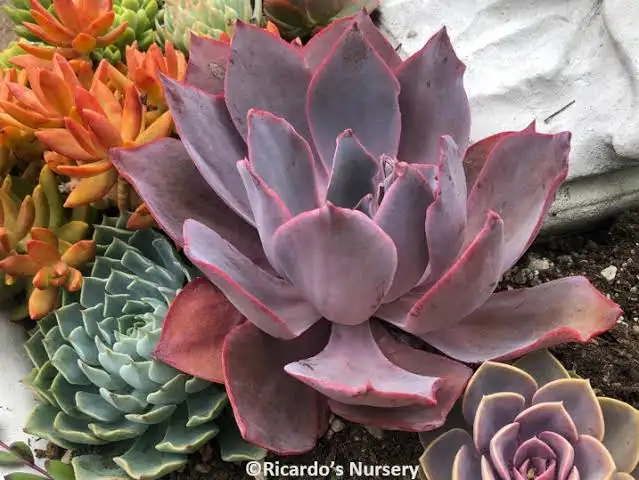
Echeveria Afterglow is a hybrid of a cross between Echeveria Cante (also known as White Cloud Echeveria) and Echeveria Shaviana (also known as the Mexican Hen). Echeveria Afterglow mimics a rose. It has a blue or lavender rosette with bright pink colouring around the edges of the leaves. During the summer season, orange-red coloured flowers can bloom from their lower leaves. The bright edges of the flower give it an ethereal look. The flower stalk must be removed as it may interfere with the growth of your Echeveria Afterglow. It can grow up to 24 inches or 61cm. It is also known as “Mexican Hen and Chicks” as it produces offset at the mother plant’s base.
Lithops optica rubra

The most popular Lithops optica grown is the ‘rubra’ because of its beautiful and strong color. The windowed leaves are pink in color with a reddish or purple hue to them. This succulent has two club shaped leaves (obconical) that grow to around an inch in diameter and a short stem that is barely visible. These leaves die off before winter sets in and produces new leaves during winter. The flowers are very similar to a daisy and grow to around an inch in diameter. Each plant will produce a single flower displaying petals that are slim with a yellow center and beautifully bright. Its natural habitat includes conditions that are dry, lots of sunshine, winter rainfall and no rainfall during summer, and huge temperature drops during the evening.
Also Read: Major Varieties of Aloe Vera
Mangave ‘Mission To Mars’

This beautiful plant represents a natural hybrid between Agave and Manfreda. It is a fast-growing succulent, it has fleshy, long, wide, lance-shaped leaves which are enclosed in a solitary rosette. The foliage is covered with large red-burgundy spots, one above the other, located so densely as to create a solid color effect of dark red (hence its name). The long leaves curve slightly downwards, while small brown teeth can be seen along the margins. With little attention Mangave will add an extravagant touch of color to both your apartments and your gardens.
Anacampseros Rufescens
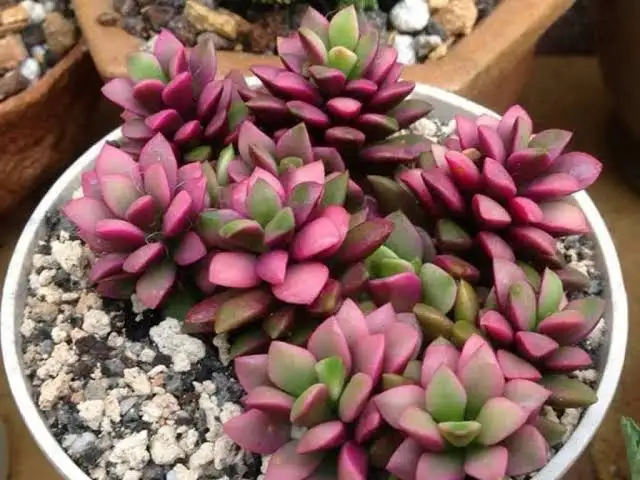
Anacampseros Rufescens, also known by its common names ‘Sunrise succulent’ and ‘Sand Rose’, is a gorgeous, low-growing succulent plant with colorful leaves. These plants grow in clusters that start out small but eventually spread out by producing offsets. The leaves are rainbow colored with foliage in the shades of green, yellow-green, purple and pink. Thin, white hairs can be seen growing around the plant. These unusual looking plant will certainly add beauty and color anywhere you place them.
Tradescantia pallida ‘Purpurea’ (Purple Heart)
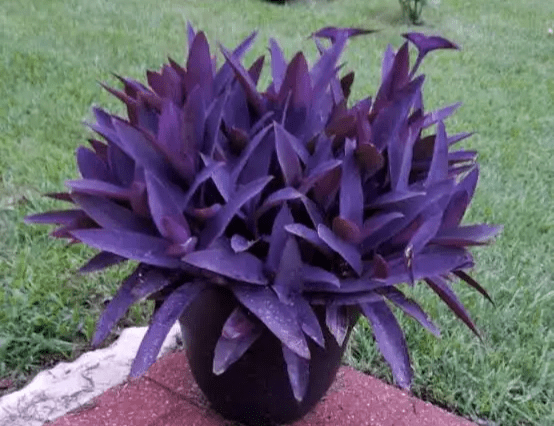
Tradescantia pallida ‘Purpurea’ (Purple Heart) is a popular trailing evergreen perennial noted for its remarkable foliage of narrow, pointed, purple leaves. Arranged alternately along thick, but fragile, purple stems, the leaves are deep royal purple above, bright violet underneath. Blooming constantly during warm weather, small clusters of bright pink, 3-petalled, pale orchid-pink flowers emerge at the stem tips. Evergreen in frost-free areas, it dies back with mild freezes but sprouts back in spring. In colder areas, it may be grown as a bedding annual, in a container or hanging basket, or as a houseplant.
Sempervivum ‘Raspberry Ice’

Sempervivum ‘Raspberry Ice’ is an ornamental, perennial succulent with tall flower stalks held atop a low mound of foliage. It has small rosettes with dense, symmetrical, raspberry-red leaves that mature more purple-red. The rosettes are lightly cobwebbed with silver hairs. Its attractive, succulent, pointy leaves emerge light green in spring, turning burgundy in color with showy, violet variegation throughout the season. It features unusual clusters of the shell, pink, star-shaped blossoms rising above the foliage in mid-summer.
Also Read: Different Types of Flowering Cactus
Pachyphytum Oviferum (moonstones)
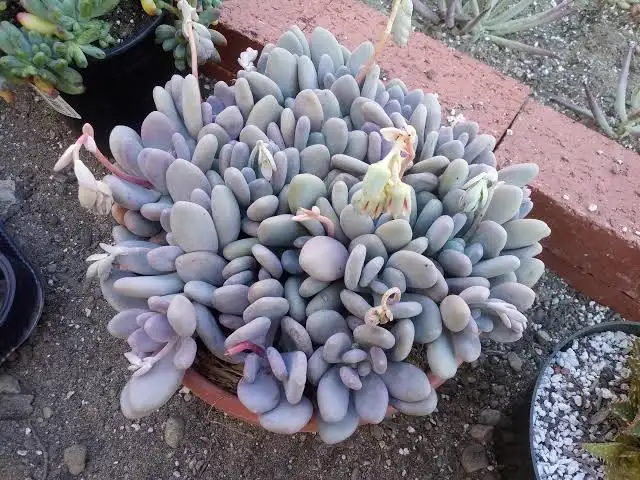
Moonstones Plant also called Sugar Almond Plant is an excellent addition to any succulent collection. It bears succulent, egg-shaped leaves. The leaves are pale blue-green to bluish-purple, looking like a sugared almond confection and hence the name, Sugar Almond. The inflorescence is comprised of 1 ft stem bearing scarlet, bell-shaped flowers which appear in the cold season. It can grow to a height of about 6 in. and a spread of 1 ft. The white stems bear up to 15 leaves each. The name Pachyphytum oviferum means a thick plant bearing eggs in reference to the thick leaves.
Opuntia santarita (Santa Rita Prickly Pear)
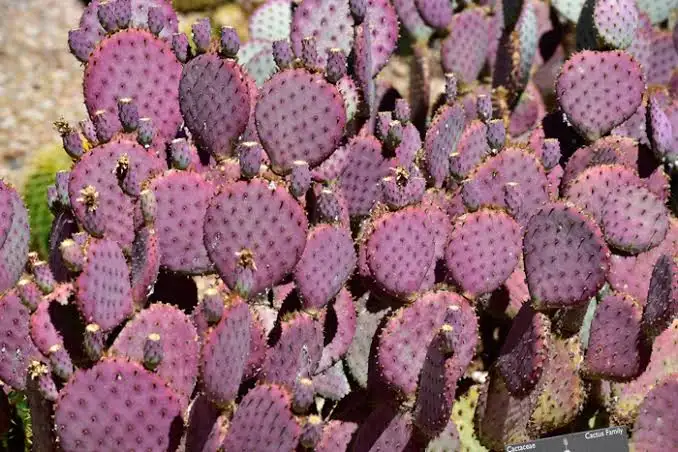
Opuntia santarita (Santa Rita Prickly Pear) is an upright, bushy succulent shrub with colorful, round, ovate, fleshy pads. Covered with spines, the pads turn rich purple in winter before changing back to soft blue gray with warmer temperatures. This purple pad coloration also intensifies in direct sunlight and drought. Sitting on the outer edges of the pads, large multi-petalled, yellow flowers appear in spring, creating a stunning contrast with the purple pads. They are followed by small edible purple fruits that are highly attractive to birds. Frost hardy, Santa Rita Prickly Pear is a very decorative cactus which adds beauty to the garden year-round.
Pleiospilos nelii ‘Royal Flush’
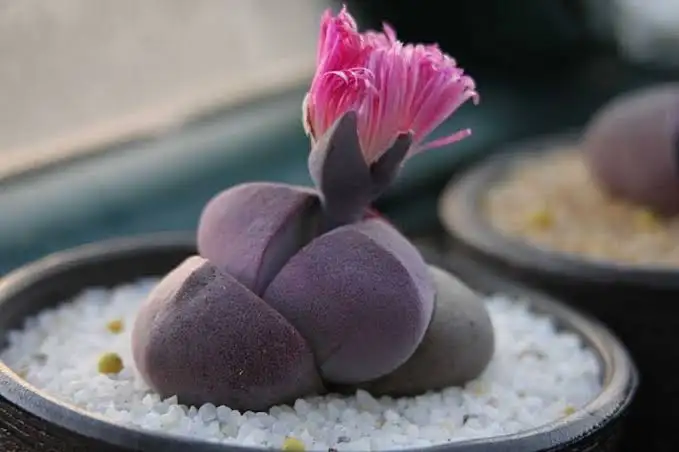
Pleiospilos nelii ‘Royal Flush’ is a type of split rock succulent, so named because of its unique appearance that allows it to camouflage against the granite rocks that cover the ground in its natural habitat. This succulent ranges from pink to purple in color, with thick, oblong leaves coated in a blanket of speckles. The plant grows three to five inches in width and height. ‘Royal Flush’ is adapted to arid desert conditions, and as such requires very bright light, which will in turn help the plant maintain its purple pigmentation. Similarly, they will not tolerate overwatering, and need extremely rapidly draining soil with very minimal organic material.
Mangave ‘Macho Mocha’

Mangave ‘Macho Mocha’ (Mangave) is a rosette-forming plant that grows to 4 to 6 feet wide and has thick, fleshy gray-green leaves densely covered with brown-purple spots. These spots are so thick toward the tip of the leaves that the entire surface is a brown-purple color. The thick reddish flower stalk rises from the middle of the plant much in the manner of an Agave. Plants remain solitary until flowering at which time several new plants will emerge from below the older rosette. Plant in full sun to light shade and water infrequently to regularly.
Also Read: Different Types of Haworthia Plants
Purple Crassula (Crassula atropurpurea)
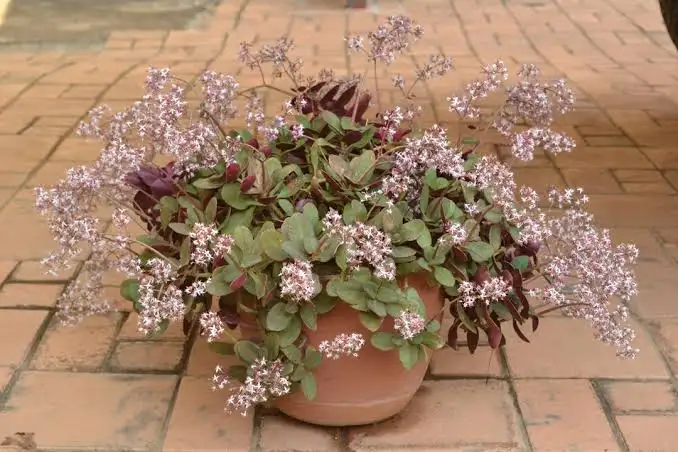
Crassula atropurpurea is a small, perennial succulent with leaves evenly spaced along erect stems. The leaves are succulent and partially waxy to the touch. The leaves are obovate-linear in shape and are flushed purple especially in summer. The individual creamy yellow flowers are produced on long, flowering spikes. This plant tends to favour rock habitats. In the Worcester area, Crassula atropurpurea is found growing in rocky crevices in Malmesbury shale. It also occurs under karroid bushes and larger succulents.
Sedeveria ‘Lilac Mist’
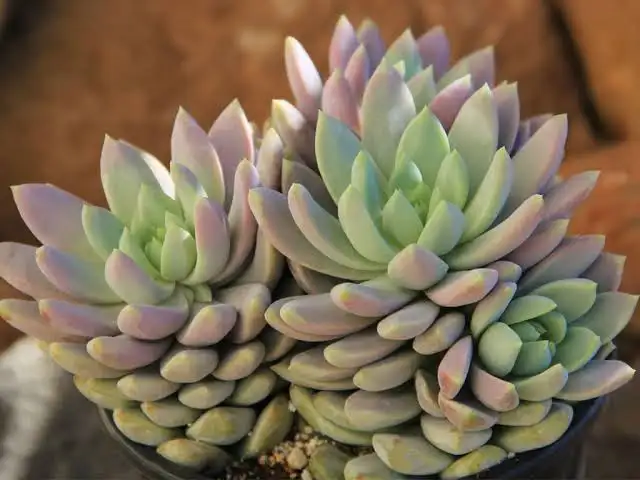
The lotus-like rosettes of Sedeveria ‘Lilac Mist’ feature thick, elongated leaves that arch slightly upward as they circle away from the center in concentric layers. Undulating shades of pastel purple, blue, and green coalesce under a coating of powdery farina, lending this specimen the hazy, misty appearance for which it is named. Most interesting however, is this specimen’s growth habit – as the stems elongate as ‘Lilac Mist’ reaches it mature size, they do not become bare, as with many rosette-shaped succulent varieties. Instead, they retain their leaves up the length of the stem, creating unique ‘towers’ of foliage sure to turn heads in even the most comprehensive succulent collection.
Kalanchoe x Houghtonii

Kalanchoe x Houghtonii is a hybrid species of Kalanchoe daigremontiana and kalanchoe delagoensis. It presents an erected stem which can reach up to 70 cm in height, equipped with fleshy boat shaped leaves, long and narrow, of a pleasant dark green maculated with purple in the bottom leaf surface. The plant can get very tall and has Flowers in the Spring that are a pink, red, orange shade and look like bells.
Also Read: Difference Between Aloe And Agave
Dark Purple Caralluma
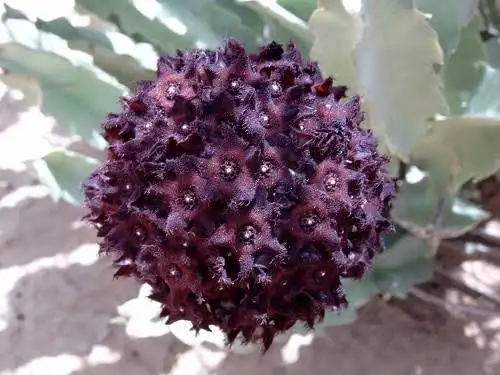
Caralluma Stalagmifera is also commonly known as the ‘Dark Purple Caralluma’. As the plant matures it can reach around 40 cm (16 inches) tall. The branches from the stem are mostly brownish to reddish but they can become 60 cm (2ft) long and around 2 cm in diameter. The leaves are star shaped and red. The plant flowers produce tiny, star-shaped dark purple flowers that have yellow tips.
Kalanchoe humilis
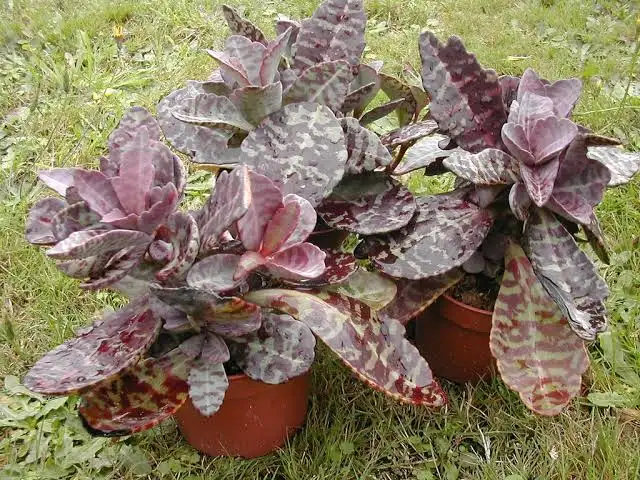
Kalanchoe humilis is tiny, perennial succulent with beautiful, numerous decorative leaves arranged in rosettes. These plants usually form clumps of rosettes that tend to expand horizontally. Their stems don’t exceed 10 centimeters in length. Close to the top of the stems, leaves tend to be more crowded. Leaves are oval and show a very beautiful brindled pattern in green and purple. Younger leaves tend to be more purplish. They are not so big, about 2-6 centimeters in width and 3-13 centimeters in length. Flowers are are small, erect or horizontal, dull purple to green.
Rainbow hedgehog cactus
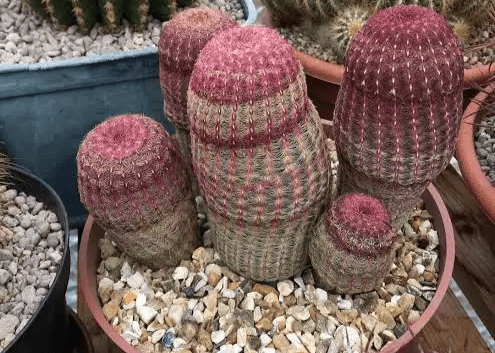
Echinocereus rigidissimus, commonly known as the Arizona Rainbow Cactus or Rainbow Hedgehog Cactus is a solitary, growing cactus, that rarely branches or offsets with age. It grows to a height of up to 30 cm, and a width of 12 cm when mature, with pectinate radial spines curved slightly towards the stem, the new spines are initially reddish to magenta and fades to a yellow or light pink colour when they mature. This cactus flowers in flushes throughout the spring season, with multiple buds borne atop the plant from younger areoles, the flowers are bright pink in colour with a white coloured throat. If pollination is successful, it forms circular shaped, greenish to dark purplish fruit, with white flesh and dark brown to black seeds approximately 3 months after flowering.
Echeveria ‘Chroma’

Resembling a sunset in plant form, Echeveria ‘Chroma’ forms rosettes of multi-hued leaves, featuring colors ranging from dark purple to bronze to peach to green! This particular Echeveria has a much shrubbier growth habit than most succulents of this type, quickly branching out to form a plant with several distinct “limbs”. ‘Chroma’s colors are prone to shifting with the seasons, putting on even more of a show as the shades of its leaves transition through their full range. Chroma can be grown outdoors in USDA hardiness zones 9b to 11, but can easily be grown indoors and brought out during warm weather in colder zones.
Sedeveria Sorrento
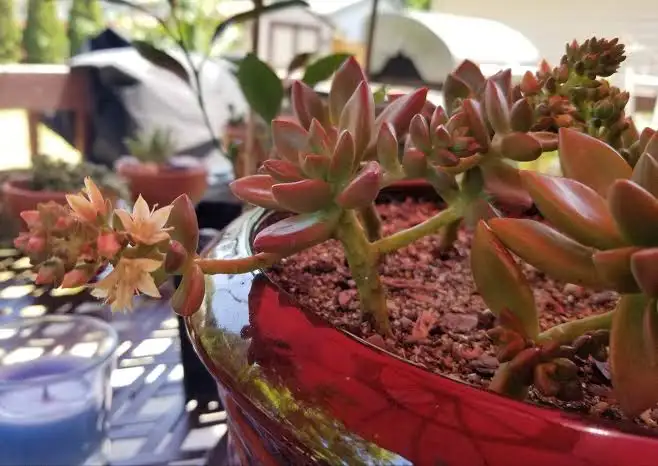
Sedeveria Sorrento is a hybrid between Sedum and Echeveria that combines the merits of both genera to yield an easy to grow, attractive succulent plant. Sedeveria Sorrento grows in a tight upright rosette that is vibrant green in the center and gradually fades to a coppery coral tone at the tips of the fleshy leaves. One of the most fun parts of growing Sedeveria is how easy they are to propagate. They can be sensitive to change in location and will usually lose a few leaves when arriving at a new location.
Gymnocalycium friedrichii ‘Purple Moon Cactus’
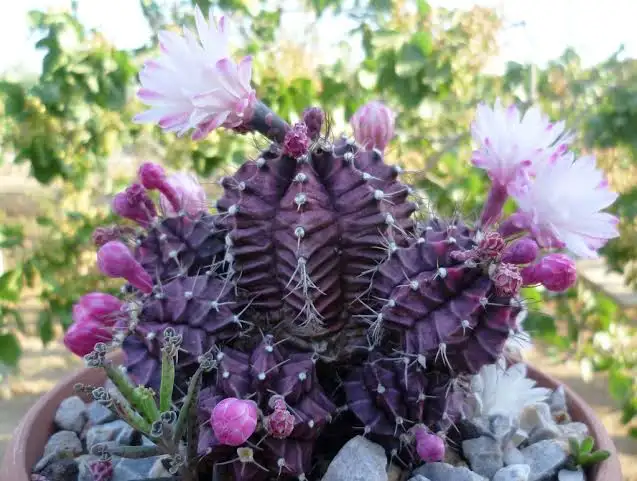
A cactus so unique it is often seen grafted atop other varieties to add a pop of color, the flesh of Gymnocalycium friedrichii ‘Purple Moon Cactus’ can range from a deep, dusky green to a dark purple, depending on the level of light exposure. Ridges along the rounded, compact barrel are dotted with fuzzy clusters of tiny spines called glochids, and large pink flowers can reach the same diameter as the plant itself. Like all cacti, Gymnocalycium friedrichii ‘Purple Moon Cactus’ prefers bright to direct sunlight, as well as a very porous soil mix.
String of heart (Ceropegia woodii)

Also referred to as string of hearts, rosary vine, chain of hearts and hearts on a string is an easy to grow and excellently rewarding ornamental houseplant. It makes for an effective subject as trailer for hanging pots or baskets and is an excellent indoor plant that grow well in half shade with average water, is evergreen, but tender to frost.
The stems have a purplish hue, as do the underside of its heart-shaped leaves. The upper surface is deep green, often with bluish-white or silvery markings. Along the stems may form aerial tubers called bulbils. White in color, the bulbils look like small beads, which may have led to the name “rosary vine”. The flowers usually have a pale magenta coloring and, although they tend to bloom most profusely in the late summer and fall, they can also appear at other times throughout the year. Five hairy petal-like extensions in a darker purple tone extend from the tip of the flower.